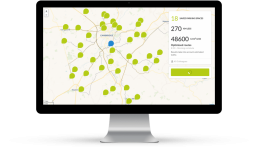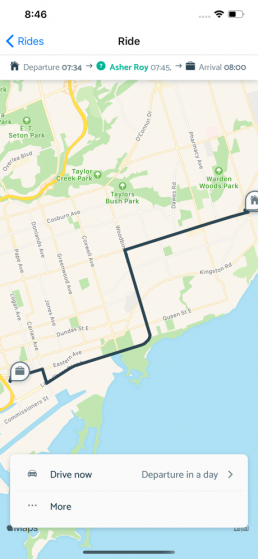Right now, the world is in a mix of remote-work and slowly opening up offices. For the foreseeable future, one thing is for sure: there will be situations where people need to travel to work, but the one thing they want to avoid is public transport.
One of the best ways to help your company’s employees is by setting up a carpool program. Doing so enables staff to travel safely, and also split travel costs, reduce stress, and more. That said, most companies aren’t set up to do this straight away – your HR department might need a little helping hand…
Want to get started? Great! We’ve prepared a handy step-by-step guide on how to start a carpool program at work so, without further ado…
1. Pick Your Carpool Type
The first step in starting a carpool program is knowing which type you want. Based on the number of employees, departments, shifts and other work factors, you will want to choose from:
- Designated drivers. In this situation, there are designated drivers for every group. It’s simpler to setup, but doesn’t scale easily, as sourcing new drivers takes time. This is essentially the equivalent of arranging private rides from within the company’s staff.
- Alternating drivers among a group of colleagues. This option can be relatively easy to set-up, as you don’t require any advanced technology and simple communication, such as via email and smartphones, can be enough. It works well for one department (that work the same shift) but, like designated drivers, it is limited in scale.
- Employees at the same company. Rather than the above two options, why not open up the program organization-wide? If people are travelling to work at the same time, it doesn’t matter which team or department they work for. Of course, this also means you need to provide a means to arrange groups – based on the proximity of people’s home locations and accounting for any changes in individual participants – but more on that later…
- Employees at the same campus or business park. Perhaps you work in a larger office or business complex, alongside multiple businesses? Well, why not get in touch and arrange for a large scale carpool program for the best results. This is also great for smaller companies that might not have enough staff alone to successfully arrange a program, but still want to support them as much as possible!
For the first two, you don’t need much more help from us – however, you’ll find that flexibility is limited and you’re essentially putting the pressure and burden on individuals within your organization. This isn’t good, for example, when a designated driver takes a sick day and your HR staff needs to do some manual work to find a new driver in time. If you’re not using an automated solution, you’ll have to face these sudden changes and emergencies, which puts more pressure and strain on the organizers.
For the latter two, you’ll need a solution on your side to support your staff in this endeavor. Again, an automated approach will be your friend here, as it will enable people to participate and find rides without putting huge burdens on the organizational team.

2. Find Out Who Is Interested
Now that you understand the needs of your workforce more, as well as an understanding of the size of the teams/departments you wish to help, you need to see who is actually interested.
A simple survey can often be enough here. Send it out, ask who wants to join as a driver, who is only a passenger, and who is willing to do a little of both.

However, this still leaves you with a lot of work to do, so why not use a more sophisticated survey solution that takes the calculations out of the equation? With Poola’s carpooling simulation, for example, you can send a similar survey, adding working hours and home locations, and let the smart program simulate how effective the actual program would be – which is also a great incentive to get people onboard!
Speaking of incentives, don’t feel afraid to offer benefits for those who take part. You can consider offering priority parking spaces or even subsidising fuel costs. It’s a good idea to mention this in the survey, as it’ll turn a more than one “no” into a “yes!”. We’ve found these carpool incentives are an essential factor for getting people’s attention – and to get them to stick with the program in the first few weeks.
3. Choose Your Technology
Now you’ve got your answers – and some willing participants – it’s time to create the platform for arranging the carpool.
If you went with one of the first two carpool types – very small groups or designated drivers – a social network will be enough. This can be Facebook, for example, or an internal communication method, such as Slack, Microsoft Teams or WhatsApp. These will enable people to talk and arrange the carpools themselves.
Yet, if you want to enable people as efficiently as possible, it’s better to go with some automation.
This is also true for the latter two groups – largest business-wide or even cross-company carpools – as well. As you scale up, it will be more difficult, and more stressful, for staff to plan their daily trips. A mobile app like Poola will make all of these problems go away, as it calculates who is travelling with who, plans the routes and does all of the hard work for everyone, adapting each day to which staff are working.

4. Set The Rules
With the participants and technology sorted, now you need to consider the rules. When talking about how to set up a carpool program, this is one area that often gets overlooked – but it’s important!
- How far ahead do you plan who is driving and sharing a ride? This will vary from place to place but you need a system for people who take vacations, for example, so they aren’t depended on during this time.
- What about people who are sick or otherwise cancel? If a driver cancels, you need a backup plan, whether it’s another driver or arranging a taxi. If someone is late, then there need to be clear rules; the drivers should only wait a certain amount of time or, if they are not notified, they may not need to wait at all. Make this clear so your staff no what to do in such scenarios.
- How do you choose the pick up location? You may need some compromise here, as there will seldom be any perfect ‘straight’ lines. It’s helpful for people to wait near the end of their roads, for example, to avoid having cars spend time turning around in neighborhoods too often.
- How do you communicate during the trip? If people are late, they need a way to update the driver, who may already be on their way. Make sure every driver has a legal and safe way to communicate, otherwise they won’t be able to answer the phone.
- How will costs be calculated and settled? Managing expenses are an important part of how to setup a carpool program – you need a fair and valid system to ensure everyone feels safe and trusted. Find a way to agree on this with your staff – whether it’s based on an equal split of the costs, or based on the distance of each home. Of course, if you’re also covering expenses on the company side, you also need an agreed fuel consumption rate for the mileage so there’s no arguments on what the costs are.
- Who will be overviewing the program and solving conflicts? You should always expect the unexpected. While an automated program like Poola can do a lot of the hard work for you, you may still need to step in and mediate any disputes. Ideally, this should be someone from an unbiased and objective point of view, such as a designated HR representative.
Many of these rules will be set and determined in the application of your choice. The more you can automate, the better! However, what’s most important here is that there are clear rules to follow. If anything is left to interpretation, this is the easiest path to confusion and internal disputes.
Use your incentives strongly here, too, to ensure as many people as possible take part. Recent studies in the US have shown that people don’t miss their commutes to work so, with a gentle nudge, there’s every chance they’ll learn to love this new, stress-free approach.

5. Start a Test Drive
Every great program needs a test run to iron out any problems. Expect issues to come in the first 2-4 weeks and use this time to finetune the program. Iteration is key here.
If you’re using software to generate reports, this will help identify where the best results are occurring, such as the most consistent/frequent carpools and those that save the most emissions, as well as who is and isn’t participating.
Here are some issues you should pay close attention to:
- Rideshare matching. Ensure whatever system you have is matching people up as well as possible. If you see matches that could obviously be improved, this is a clear sign that a change could help!
- Employee schedules. If there are mismatches between employee working hours, is this something your company could change to better enable the rideshare scheme?
- Last-minute cancellations. These will happen sooner or later, so make sure your plan (such as taxis or backup drivers) works well.
- Engagement levels. In the first few weeks, you should compare your engagement levels with the initial interest expressed during the survey. Is it the same, more or less? If the numbers aren’t good enough, then you need to consider better incentives or more research to find out why.
Give yourself two weeks and make any potential changes based on this feedback. A little refinement never hurts!
How To Start A Carpool Program At Work
As you can see, setting up a carpool program is easy! All it takes is an eager workforce, a little preparation on the company’s behalf and some technology to organize everyone together.
And one last quick tip: the less work you make it for individual employees to take part, the more eager they will be.
That being said, the average American has a commute of just under 2 hours (a length of time that previous sources have suggested is slowly increasing each year, too) – and that’s in busy metro areas, where transportation should be readily available – so you’ll likely have a few volunteers right from the start!
While there are a number of steps at the start, this is the majority of the work you’ll ever need to do. Better yet, with a solution like Poola, we’ll even take care of it for you. In addition to our app, we’ll also:
- Provide initial consultation regarding best practices and advice on how to set up a carpool program at work – tailored to your specific situation.
- Run a survey among your employees to assess their interest.
- Utilize our simulation program to give you the expected results, including how much parking space will be saved, the reduced carbon footprint, and the distances/times reduced to employee commutes.
- Configure the system and deliver a mobile app that’s ready for all your employees.
- Motivate and help ensure usage is as high as possible
- Monitor the system and generate any needed reports.
- Solve problems such as rideshare matching and employee schedules, thanks to our app’s algorithms and the direct involvement of one of Poola’s community managers – a dedicated person you can always count on.
- Support you and your team members 24/7!
There you go: how to set up a carpool program at work! Follow these steps in order and you’ll be able to get started easily – but if you want some expert assistance (and a lot of shortcuts), get in touch!


